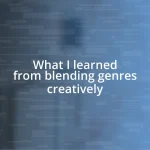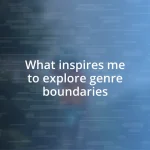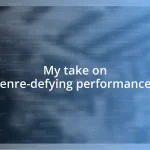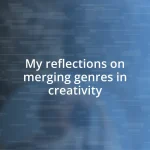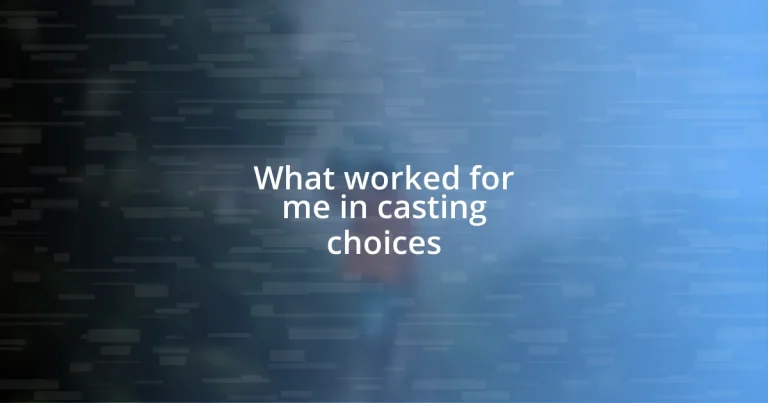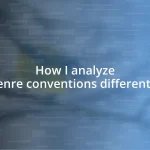Key takeaways:
- Chemistry between actors is crucial for creating believable performances and engaging audiences; evaluating subtle interactions can reveal their potential connection.
- Finding the right character fit involves considering emotional resonance, physicality, and individual interpretive insights, which can lead to surprising and enriching portrayals.
- Community feedback and collaboration in the casting process enhance decision-making, while trusting one’s instincts and keeping an open mind can lead to unexpected and successful casting choices.
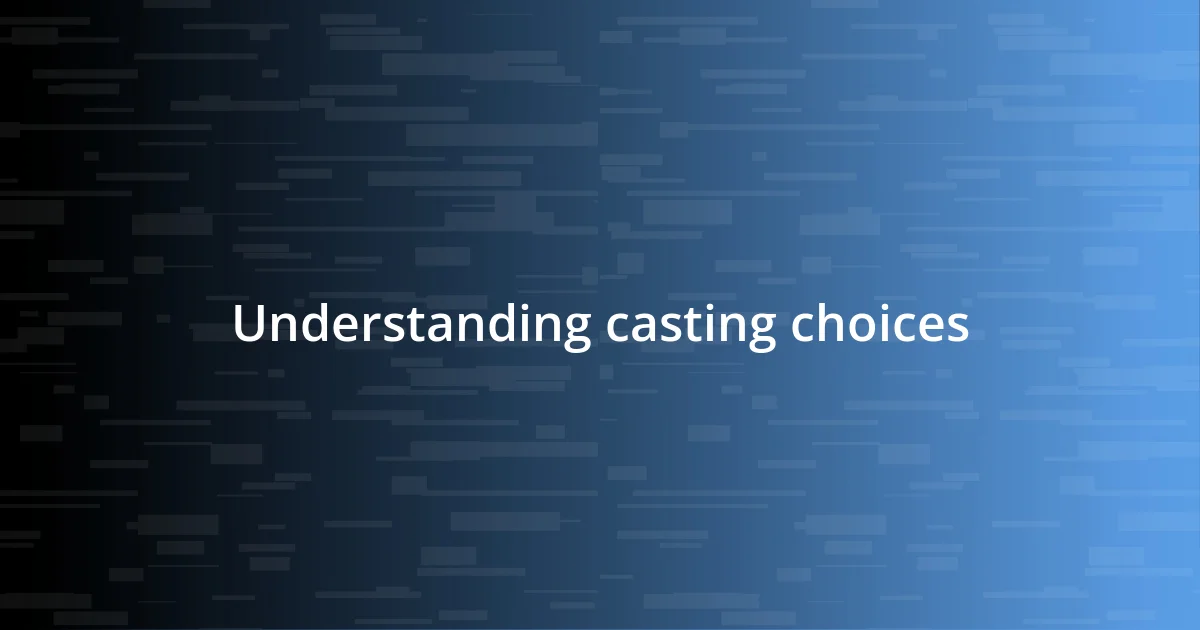
Understanding casting choices
Casting choices can be incredibly nuanced. I remember attending a workshop where a director emphasized the importance of chemistry between actors. It made me realize how pivotal this element is—not just for believability, but for drawing the audience into the story. Have you ever watched a scene that felt flat? It’s often due to a lack of genuine connection between the performers.
When selecting a cast, I’ve found that it’s not just about talent; it’s about how the actor fits the vision of the character as much as their skill level. For instance, I once chose an actor who seemed unconventional for the role, but their unique interpretation brought a fresh perspective that truly enhanced the narrative. It’s fascinating how sometimes stepping away from the obvious choice can lead to something remarkable.
I often ask myself, what does each character bring to the table? Each choice should not only resonate with the script but also create a dynamic interplay that elevates the production. I’ve seen projects where the ensemble cast blended seamlessly, and it felt like magic—there’s a palpable energy that can’t be manufactured. Have you felt that too? That sense of harmony is what transforms casting from merely a decision into an art form.
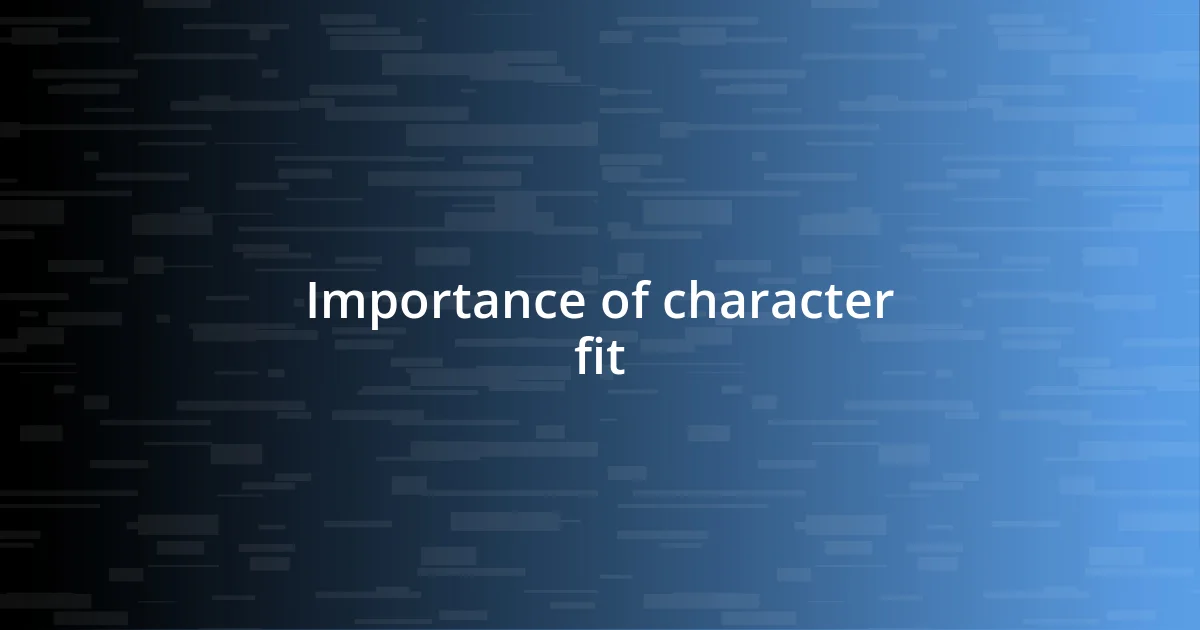
Importance of character fit
Finding the right character fit is crucial. I’ve had moments where the perfect actor stepped into a role and just clicked. It wasn’t just the lines they delivered; it was the way they embodied the essence of the character. I remember one production where I cast an actor who at first glance didn’t seem to fit the mold, but once on stage, their portrayal breathed life into the character in ways I never anticipated.
Here are some key considerations regarding character fit:
- Emotional Resonance: Does the actor connect with the character’s experiences? I’ve often noticed that actors who relate personally to their roles deliver performances that resonate deeply with audiences.
- Physicality: It’s not just about looks, but how an actor moves and carries themselves. I once cast an actor whose physical presence transformed how the character was perceived—adding layers of depth through their unique body language.
- Interpretive Insight: I find that casting someone who can bring their individual flair to the character often results in unexpected, enriching choices—ones that keep the audience engaged and intrigued.

Evaluating actor chemistry
Evaluating actor chemistry truly transforms the viewing experience. I’ve been in the audience, watching two actors on stage, and it was incredible to witness their authentic connection. There was an unspoken language between them, which made the scene charged with emotion—it felt real. Have you ever felt captivated by a performance where the chemistry seemed almost electric? It’s that kind of connection that not only engages but also pulls the audience into the narrative.
In another instance, I cast two actors for a romantic scene, and initially, I doubted their compatibility based on their audition tapes. However, once they started rehearsing together, their chemistry surprised me. They began to play off each other’s energy, crafting a fluidity that was mesmerizing. This experience reaffirmed my belief that your gut feeling during auditions about actor chemistry can sometimes lead to delightful surprises.
Evaluating chemistry is also about the subtleties—watching how actors interact during read-throughs can reveal so much. I always pay attention to their nuances: the glances, the pauses, and even their laughter together. These small details can hint at whether they can create that necessary bond on stage or screen. Have you noticed that the little moments often make the biggest impact?
| Chemistry Element | Importance |
|---|---|
| Emotional Alignment | Creates believable performances, allowing audiences to connect deeply |
| Energy Exchange | Facilitates a dynamic flow that enriches each scene |
| Subtle Interactions | Enhances realism through unspoken communication |
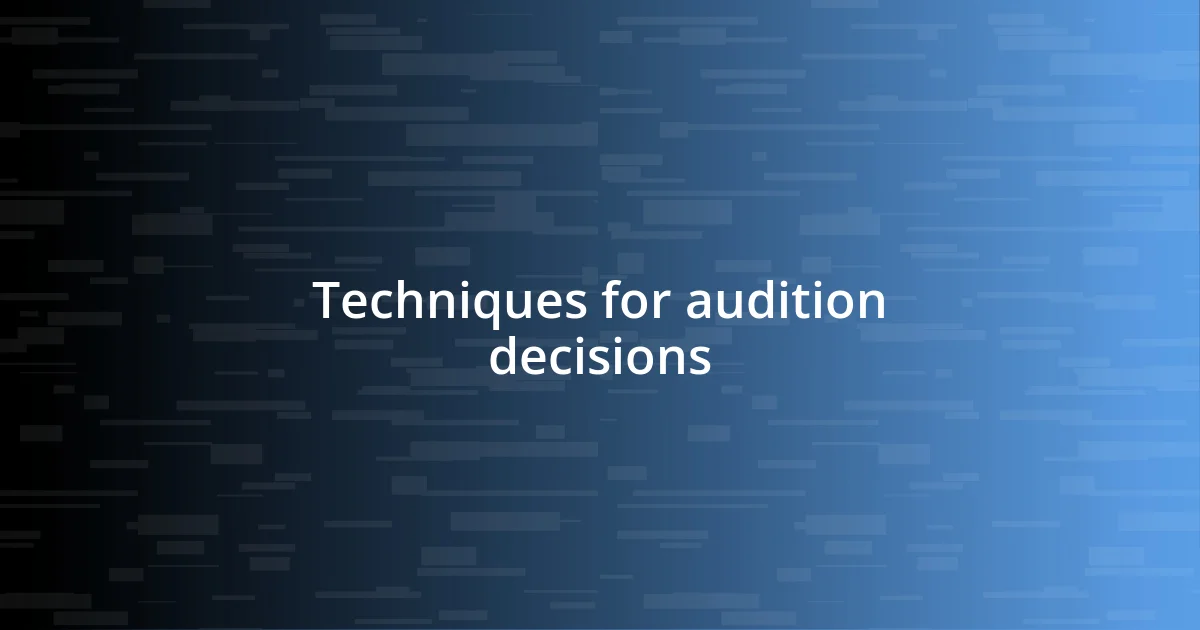
Techniques for audition decisions
Deciding on audition choices is more than just selecting the most skilled performers; it’s about capturing the essence of what you envision for your project. I once had a talented actress audition for a role and completely missed the subtext in her performance during callbacks. It wasn’t until I saw a rehearsed scene with her in context that I realized how her approach could elevate the narrative. Have you ever overlooked talent because it didn’t align with your original vision? That experience reminded me to keep an open mind and consider how actors might surprise you when given the right material.
Another technique I find invaluable is conducting improvisation exercises during auditions. There was a time when I had two actors audition for a dramatic scene but felt uncertain about their depth in conveying emotion. When I prompted them to improvise a related scenario, their performances transformed dramatically. They tapped into a raw vulnerability that didn’t come through in their scripted readings. This taught me that pushing the actors out of their comfort zones can unveil hidden gems—moments that resonate with truth and authenticity.
Finally, it’s essential to trust your instincts during the audition process. I learned this when casting a new project; one actor stood out from the rest by simply being himself. His audition felt like a breath of fresh air. It sparked my curiosity and excitement about the project. When you feel something genuine during an audition, it’s often a sign that the actor has what it takes to connect with the audience. So, how often do you listen to that inner voice urging you to take a chance? Embracing those feelings can lead to unexpected and rewarding casting choices.
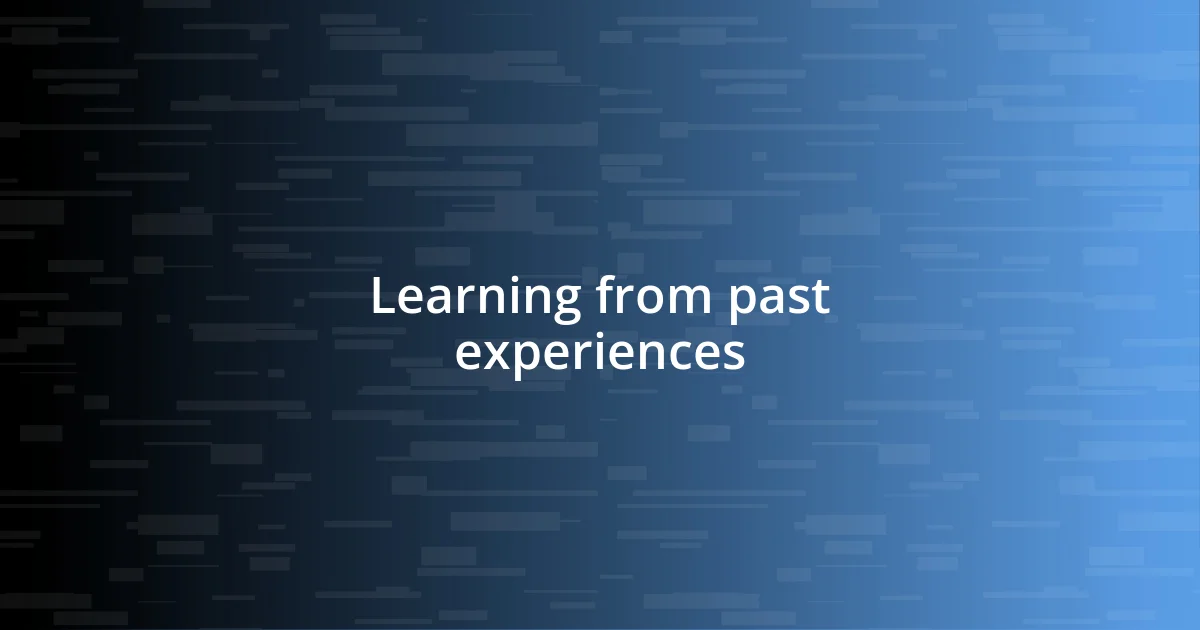
Learning from past experiences
Reflecting on past casting experiences has been invaluable for me. I remember casting a supporting role where my past choices led me to prioritize conventional talent over uniqueness. Looking back, I realize that sometimes the less obvious choices bring fresh perspectives that can enhance a project. Have you ever considered how a surprising choice can add layers to a story?
One particular audition sticks in my mind. I initially overlooked a performer because she didn’t fit the mold I had envisioned. However, during a callback, she brought such intensity and authenticity to her character that it became clear she could transform the role. This taught me that breaking away from preconceived notions can lead to fruitful discoveries. How often do we box ourselves in with expectations?
I’ve also found that journaling about past casting decisions helps me identify patterns. When I review my notes, I can see where I thrived and where I faltered. This process deepens my understanding of what truly resonates in performances. Have you ever paused to document your casting journey? A little reflection can illuminate your path forward and help you make more informed choices next time.
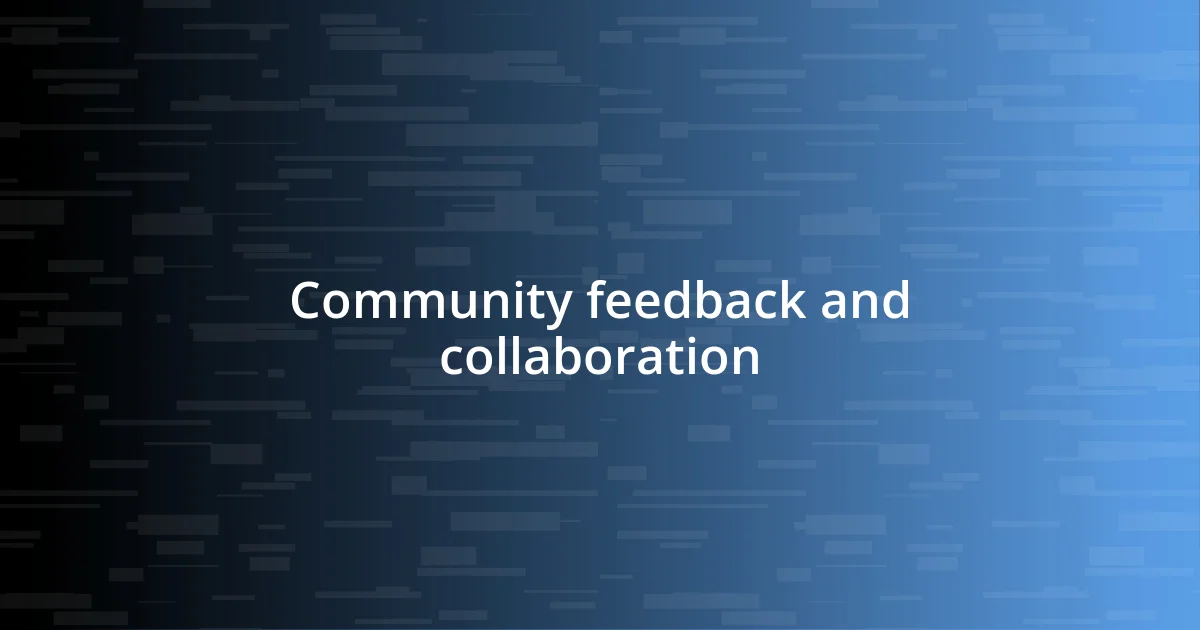
Community feedback and collaboration
Community feedback has profoundly shaped my casting choices over the years. I recall a particular instance where I held a casting session for a community theater production. After the auditions, I invited fellow directors and actors to share their thoughts. Their perspectives opened my eyes to nuances I had missed, highlighting a candidate whose energy was infectious. Is there a more valuable resource than the collective insights of those in the room?
Collaboration also plays a key role in my decision-making process. When I worked on a short film, I partnered closely with the cinematographer. As we discussed the emotional tone we wanted, it became clear how certain actors embodied that vision better than others. Their input, based on visual storytelling, drove me to rethink my initial choices. Have you ever felt how a collaborative environment can reveal new possibilities?
I’ve noticed that fostering an open dialogue within my casting team leads to richer outcomes. One time, during a casting workshop, I encouraged everyone to share their impressions of each audition. The discussion not only highlighted attributes I had overlooked but also sparked an engaging conversation about character motivations. How often do you create space for diverse opinions to flourish in your creative process? Embracing this collaboration can truly enhance the casting journey.
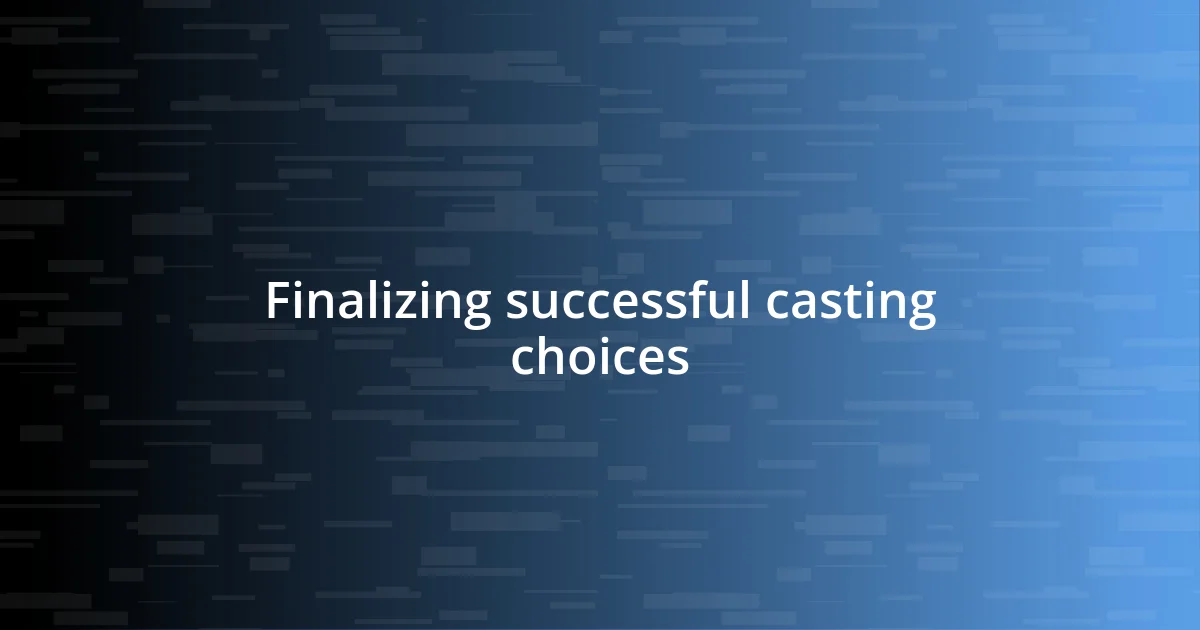
Finalizing successful casting choices
Fine-tuning casting choices often hinges on instinct. I remember a time when I was torn between two actors for a lead role. Although one had the more polished resume, I felt an undeniable spark with the other. Trusting that gut feeling ended up being a game-changer, as that choice brought a magnetic chemistry to the project that elevated the entire narrative. Have you ever gone with your intuition and found it paid off?
Additionally, I find that creating a mock rehearsal with potential cast members can illuminate my decisions significantly. One time, I gathered a small group to read scenes together, and it was enlightening to see their dynamic unfold. The synergy among the actors revealed who could truly embody the ensemble’s spirit and drive the story forward. Have you tried this approach to visualize your casting choices before making them final?
Finally, keeping an open mind right up until the casting is confirmed has been crucial for me. There was a situation where I almost settled on an actor who was considered a safe pick. It wasn’t until the last minute that I revisited another audition tape and found an actor who redefined my expectations. That last-minute change not only invigorated my enthusiasm but also made the project more compelling than I had originally imagined. Do you allow yourself the flexibility to pivot when new insights spark your interest?


